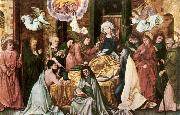Großhandels China Öl Gemälde & Rahmt Ein |
|||||||||||

|
|||||||||||
|
|
|
||||||||||||||
|
HOLBEIN, Hans the Elder
(b. 1460/65, Augsburg, d. 1524, Isenheim |
||||||||||||||
|
|
||||||||||||||
|
||||||||||||||
|
|
||||||||||||||
| HOLBEIN, Hans the Elder
(b. 1460/65, Augsburg, d. 1524, Isenheim 1490 Tempera on oak panel, 150 x 228,5 cm Museum of Fine Arts, Budapest Signed on the censer: HANS. HOLPAIN. At the turn of the sixteenth century Hans Holbein the Elder, famous painter of altarpieces and portraits, was the leading painter of the rich merchant city of Augsburg. The painting in Budapest is one of his finest works and, indeed, one of the most significant works of German painting at that time. The inscription tells us that it was commissioned by Wolfgang Preu, Canon of Rottenbuch between 1490 and 1500 and that it originally decorated the tomb of the Preu family in the Church of St James at Straubing. The death of the Virgin is placed in a contemporary domestic setting. Mary, represented as a middle-class woman of Augsburg and wearing the clothes of the period, is seen lying on her canopied bed with the Apostles grouped about her like her family - one of them, wearing spectacles, is reading from the Bible. The artist follows the medieval tradition of simultaneous narration by depicting the sequel in the same picture: at the top we see the Virgin's soul, in the form of an innocent young girl in white, ascending to heaven to be received by God the Father. The Virgin Mary is seen surrounded by the apostles assembled, according to the Legenda Aurea, by divine miracle from various remote parts of the world for this solemn occasion. Though they cannot have met for a long time, they do not speak to one another; uncontestably the Virgin remains the centre of the scene. Every activity, every gesture of pain is directed towards her. She is seated in their midst, fragile and graceful, with a dreamy face - of all the faces in the picture hers shows the finest painting - and a halo around her head representing the supernatural element which is, however, hidden by a bonnet, a concession to wordly fashion. The picture is, indeed, marked by a mixture of accentuated verisimilar and supernatural elements. The young apostle-sitting before the bed, absorbed in reading and taking no part in the social gathering - who wears a kind of pince-nez in accordance with the customs of those days, is a veritable genre figure. The books lying on the bed, the censers and aspersorium painted with equally meticulous precision became ubiquitous pieces of the still-lifes of subsequent ages. In this painting Holbein, with exquisite taste and force, blends the traditional, late Gothic approach with a new style of representing nature and reality adopted from Netherlandish painting |
||||||||||||||
|
Related Paintings to HOLBEIN, Hans the Elder :. |
||||||||||||||
|
|
||||||||||||||
|
|
||||||||||||||
|
KONTAKTIEREN Sie UNS |







